VOLVO V90 2017 Owners Manual
Manufacturer: VOLVO, Model Year: 2017, Model line: V90, Model: VOLVO V90 2017Pages: 594, PDF Size: 15.07 MB
Page 371 of 594
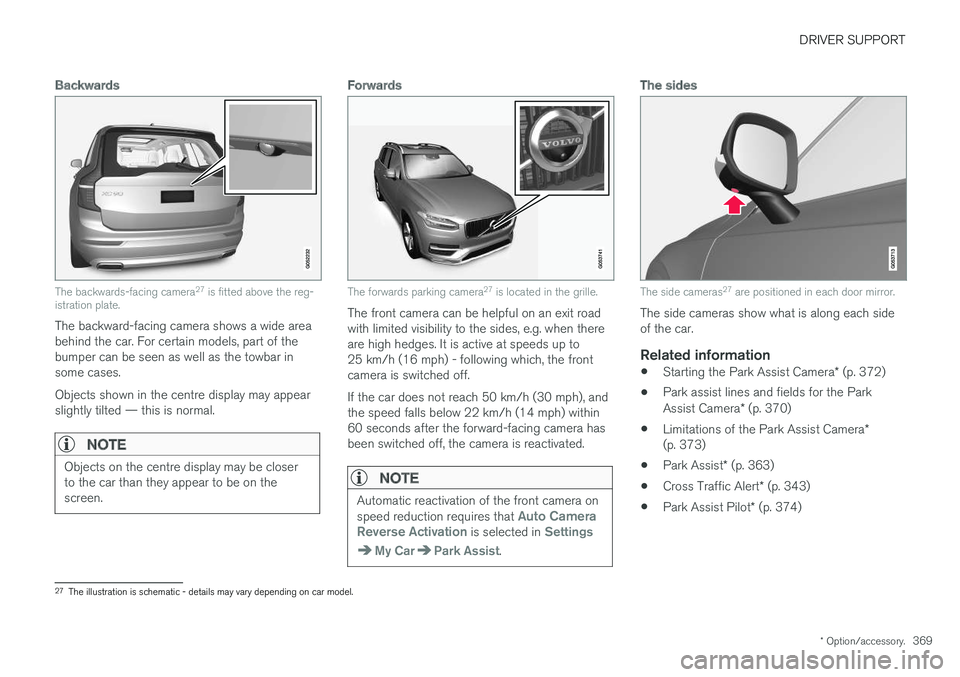
DRIVER SUPPORT
* Option/accessory.369
Backwards
The backwards-facing camera 27
is fitted above the reg-
istration plate.
The backward-facing camera shows a wide area behind the car. For certain models, part of thebumper can be seen as well as the towbar insome cases. Objects shown in the centre display may appear slightly tilted — this is normal.
NOTE
Objects on the centre display may be closer to the car than they appear to be on thescreen.
Forwards
The forwards parking camera 27
is located in the grille.
The front camera can be helpful on an exit road with limited visibility to the sides, e.g. when thereare high hedges. It is active at speeds up to25 km/h (16 mph) - following which, the frontcamera is switched off. If the car does not reach 50 km/h (30 mph), and the speed falls below 22 km/h (14 mph) within60 seconds after the forward-facing camera hasbeen switched off, the camera is reactivated.
NOTE
Automatic reactivation of the front camera on speed reduction requires that Auto Camera
Reverse Activation is selected in Settings
My CarPark Assist.
The sides
The side cameras 27
are positioned in each door mirror.
The side cameras show what is along each side of the car.
Related information
• Starting the Park Assist Camera
* (p. 372)
• Park assist lines and fields for the Park Assist Camera
* (p. 370)
• Limitations of the Park Assist Camera
*
(p. 373)
• Park Assist
* (p. 363)
• Cross Traffic Alert
* (p. 343)
• Park Assist Pilot
* (p. 374)
27
The illustration is schematic - details may vary depending on car model.
Page 372 of 594
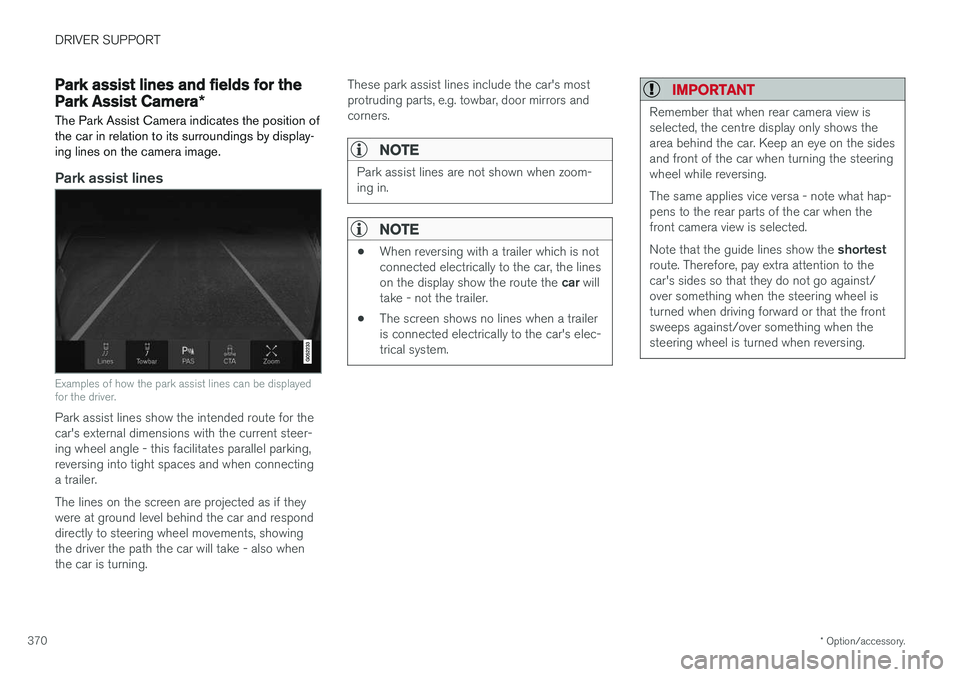
DRIVER SUPPORT
* Option/accessory.
370
Park assist lines and fields for the Park Assist Camera *
The Park Assist Camera indicates the position of the car in relation to its surroundings by display-ing lines on the camera image.
Park assist lines
Examples of how the park assist lines can be displayed for the driver.
Park assist lines show the intended route for the car's external dimensions with the current steer-ing wheel angle - this facilitates parallel parking,reversing into tight spaces and when connectinga trailer. The lines on the screen are projected as if they were at ground level behind the car and responddirectly to steering wheel movements, showingthe driver the path the car will take - also whenthe car is turning. These park assist lines include the car's mostprotruding parts, e.g. towbar, door mirrors andcorners.
NOTE
Park assist lines are not shown when zoom- ing in.
NOTE
•
When reversing with a trailer which is not connected electrically to the car, the lines on the display show the route the
car will
take - not the trailer.
• The screen shows no lines when a trailer is connected electrically to the car's elec-trical system.
IMPORTANT
Remember that when rear camera view is selected, the centre display only shows thearea behind the car. Keep an eye on the sidesand front of the car when turning the steeringwheel while reversing. The same applies vice versa - note what hap- pens to the rear parts of the car when thefront camera view is selected. Note that the guide lines show the
shortest
route. Therefore, pay extra attention to the car's sides so that they do not go against/over something when the steering wheel isturned when driving forward or that the frontsweeps against/over something when thesteering wheel is turned when reversing.
Page 373 of 594
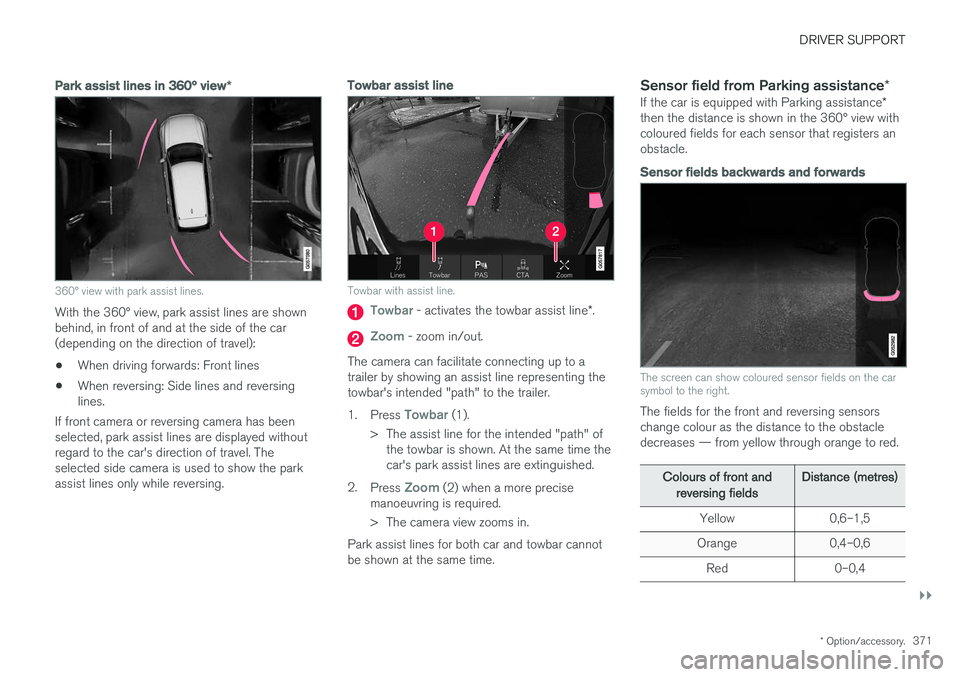
DRIVER SUPPORT
}}
* Option/accessory.371
Park assist lines in 360° view *
360° view with park assist lines.
With the 360° view, park assist lines are shown behind, in front of and at the side of the car(depending on the direction of travel):
• When driving forwards: Front lines
• When reversing: Side lines and reversinglines.
If front camera or reversing camera has beenselected, park assist lines are displayed withoutregard to the car's direction of travel. Theselected side camera is used to show the parkassist lines only while reversing.
Towbar assist line
Towbar with assist line.
Towbar - activates the towbar assist line *.
Zoom - zoom in/out.
The camera can facilitate connecting up to a trailer by showing an assist line representing thetowbar's intended "path" to the trailer. 1. Press
Towbar (1).
> The assist line for the intended "path" of the towbar is shown. At the same time the car's park assist lines are extinguished.
2. Press
Zoom (2) when a more precise
manoeuvring is required.
> The camera view zooms in.
Park assist lines for both car and towbar cannot be shown at the same time.
Sensor field from Parking assistance *
If the car is equipped with Parking assistance *
then the distance is shown in the 360° view withcoloured fields for each sensor that registers anobstacle.
Sensor fields backwards and forwards
The screen can show coloured sensor fields on the car symbol to the right.
The fields for the front and reversing sensors change colour as the distance to the obstacledecreases — from yellow through orange to red.
Colours of front and
reversing fields Distance (metres)
Yellow 0,6–1,5
Orange 0,4–0,6 Red 0–0,4
Page 374 of 594
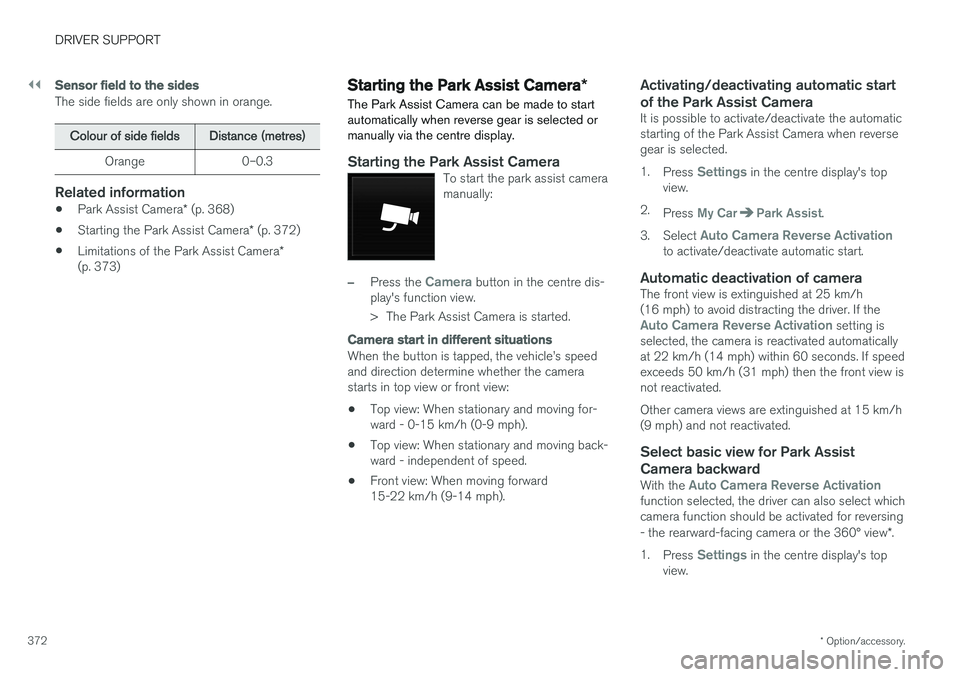
||
DRIVER SUPPORT
* Option/accessory.
372
Sensor field to the sides
The side fields are only shown in orange.
Colour of side fields Distance (metres)
Orange 0–0.3
Related information
• Park Assist Camera
* (p. 368)
• Starting the Park Assist Camera
* (p. 372)
• Limitations of the Park Assist Camera
*
(p. 373)
Starting the Park Assist Camera *
The Park Assist Camera can be made to start automatically when reverse gear is selected ormanually via the centre display.
Starting the Park Assist CameraTo start the park assist camera manually:
–Press the Camera button in the centre dis-
play's function view.
> The Park Assist Camera is started.
Camera start in different situations
When the button is tapped, the vehicle
Page 375 of 594
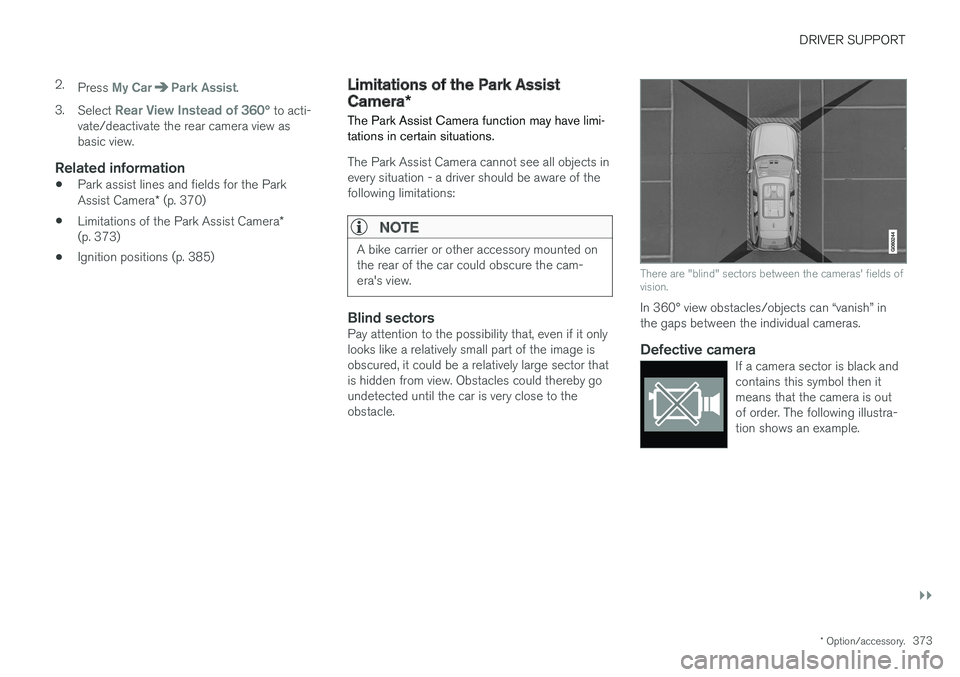
DRIVER SUPPORT
}}
* Option/accessory.373
2.
Press
My CarPark Assist.
3. Select
Rear View Instead of 360° to acti-
vate/deactivate the rear camera view as basic view.
Related information
• Park assist lines and fields for the Park Assist Camera
* (p. 370)
• Limitations of the Park Assist Camera
*
(p. 373)
• Ignition positions (p. 385)
Limitations of the Park Assist Camera
*
The Park Assist Camera function may have limi- tations in certain situations.
The Park Assist Camera cannot see all objects in every situation - a driver should be aware of thefollowing limitations:
NOTE
A bike carrier or other accessory mounted on the rear of the car could obscure the cam-era's view.
Blind sectorsPay attention to the possibility that, even if it only looks like a relatively small part of the image isobscured, it could be a relatively large sector thatis hidden from view. Obstacles could thereby goundetected until the car is very close to theobstacle.
There are "blind" sectors between the cameras' fields of vision.
In 360° view obstacles/objects can “vanish” in the gaps between the individual cameras.
Defective cameraIf a camera sector is black andcontains this symbol then itmeans that the camera is outof order. The following illustra-tion shows an example.
Page 376 of 594

||
DRIVER SUPPORT
* Option/accessory.
374
The car's left-hand camera is out of order.
Black camera sector
A black camera sector is also shown in the fol- lowing instances, but then without the symbol for
defective camera:
• open door
• open tailgate
• folded-in door mirror.
Light conditionsThe camera image is adjusted automatically according to prevailing light conditions. Becauseof this, the image may vary slightly in brightnessand quality. Poor light conditions can result inreduced image quality.
MaintenanceClean camera lenses regularly with lukewarmwater and car shampoo - be careful not toscratch the lenses.
NOTE
Keep the camera lens clear of dirt, snow and ice to ensure optimum function. This is partic-ularly important in poor light.
Related information
•
Park Assist Camera
* (p. 368)
• Starting the Park Assist Camera
* (p. 372)
• Park assist lines and fields for the Park Assist Camera
* (p. 370)
Park Assist Pilot *
Active parking assistance (Park Assist Pilot - PAP) helps the driver to park in or leave a park-ing space.
PAP checks first if a space is sufficiently big and thereafter helps the driver to turn the steeringwheel and manoeuvre the car into the space. The centre display indicates with symbols, graph- ics and text the various operations to be carriedout and when to do so.
NOTE
The PAP function measures the space and steers the car - the driver's task is to:
• keep a close watch around the car
• follow the instructions in the centre dis-play
• change gear (reverse/forward)
• control and maintain a safe speed
• brake and stop.
Page 377 of 594
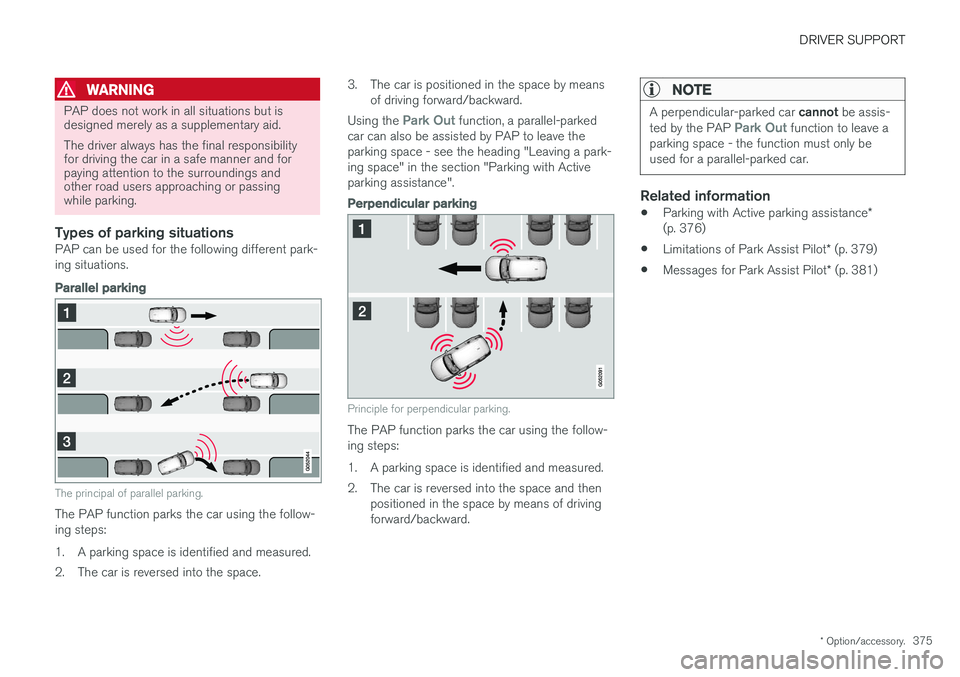
DRIVER SUPPORT
* Option/accessory.375
WARNING
PAP does not work in all situations but is designed merely as a supplementary aid. The driver always has the final responsibility for driving the car in a safe manner and forpaying attention to the surroundings andother road users approaching or passingwhile parking.
Types of parking situationsPAP can be used for the following different park- ing situations.
Parallel parking
The principal of parallel parking.
The PAP function parks the car using the follow- ing steps:
1. A parking space is identified and measured.
2. The car is reversed into the space. 3. The car is positioned in the space by means
of driving forward/backward.
Using the
Park Out function, a parallel-parked
car can also be assisted by PAP to leave the parking space - see the heading "Leaving a park-ing space" in the section "Parking with Activeparking assistance".
Perpendicular parking
Principle for perpendicular parking.
The PAP function parks the car using the follow- ing steps:
1. A parking space is identified and measured.
2. The car is reversed into the space and then positioned in the space by means of driving forward/backward.
NOTE
A perpendicular-parked car cannot be assis-
ted by the PAP Park Out function to leave a
parking space - the function must only be used for a parallel-parked car.
Related information
• Parking with Active parking assistance
*
(p. 376)
• Limitations of Park Assist Pilot
* (p. 379)
• Messages for Park Assist Pilot
* (p. 381)
Page 378 of 594
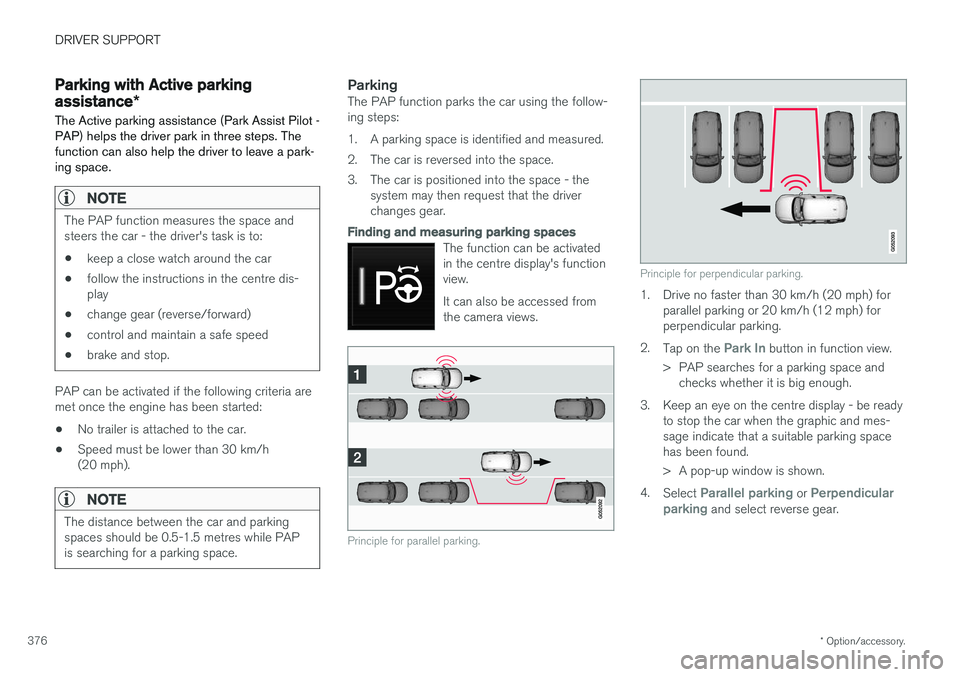
DRIVER SUPPORT
* Option/accessory.
376
Parking with Active parking assistance *
The Active parking assistance (Park Assist Pilot - PAP) helps the driver park in three steps. Thefunction can also help the driver to leave a park-ing space.
NOTE
The PAP function measures the space and steers the car - the driver's task is to:
• keep a close watch around the car
• follow the instructions in the centre dis-play
• change gear (reverse/forward)
• control and maintain a safe speed
• brake and stop.
PAP can be activated if the following criteria are met once the engine has been started:
• No trailer is attached to the car.
• Speed must be lower than 30 km/h(20 mph).
NOTE
The distance between the car and parking spaces should be 0.5-1.5 metres while PAPis searching for a parking space.
ParkingThe PAP function parks the car using the follow- ing steps:
1. A parking space is identified and measured.
2. The car is reversed into the space.
3. The car is positioned into the space - the
system may then request that the driver changes gear.
Finding and measuring parking spaces
The function can be activated in the centre display's functionview. It can also be accessed from the camera views.
Principle for parallel parking.
Principle for perpendicular parking.
1. Drive no faster than 30 km/h (20 mph) forparallel parking or 20 km/h (12 mph) for perpendicular parking.
2. Tap on the
Park In button in function view.
> PAP searches for a parking space and checks whether it is big enough.
3. Keep an eye on the centre display - be ready to stop the car when the graphic and mes- sage indicate that a suitable parking spacehas been found.
> A pop-up window is shown.
4. Select
Parallel parking or Perpendicular
parking and select reverse gear.
Page 379 of 594
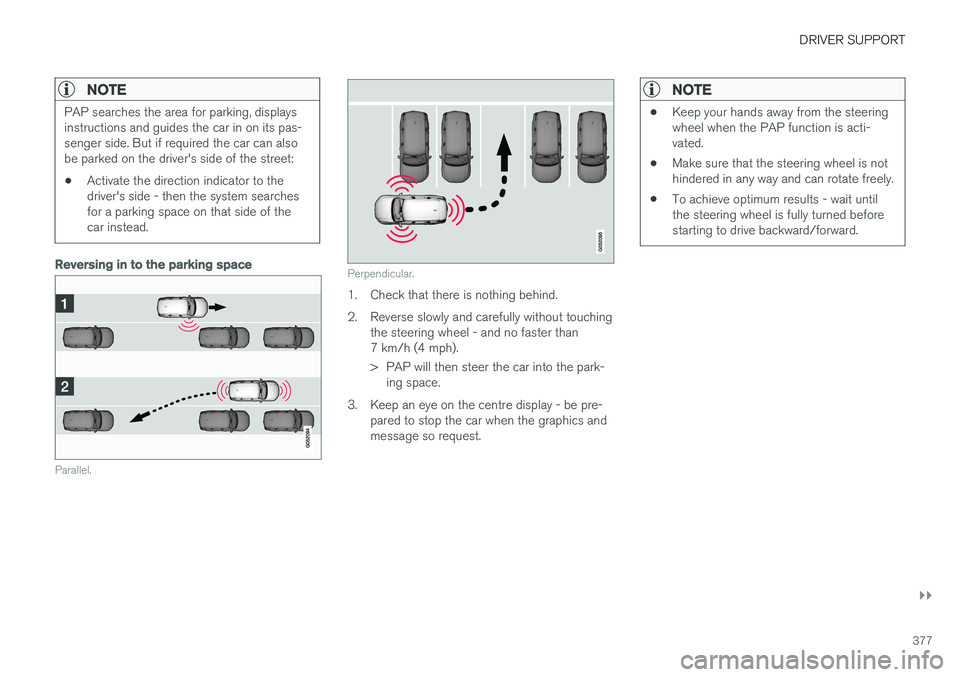
DRIVER SUPPORT
}}
377
NOTE
PAP searches the area for parking, displays instructions and guides the car in on its pas-senger side. But if required the car can alsobe parked on the driver's side of the street: •Activate the direction indicator to the driver's side - then the system searchesfor a parking space on that side of thecar instead.
Reversing in to the parking space
Parallel.
Perpendicular.
1. Check that there is nothing behind.
2. Reverse slowly and carefully without touching
the steering wheel - and no faster than 7 km/h (4 mph).
> PAP will then steer the car into the park-ing space.
3. Keep an eye on the centre display - be pre- pared to stop the car when the graphics and message so request.
NOTE
• Keep your hands away from the steering wheel when the PAP function is acti-vated.
• Make sure that the steering wheel is nothindered in any way and can rotate freely.
• To achieve optimum results - wait untilthe steering wheel is fully turned beforestarting to drive backward/forward.
Page 380 of 594
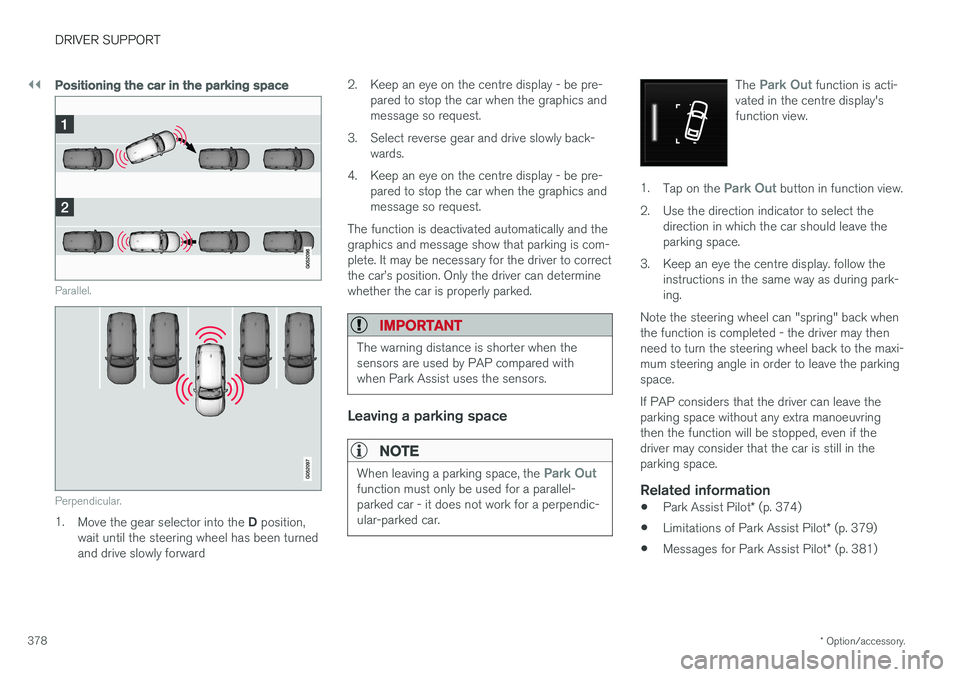
||
DRIVER SUPPORT
* Option/accessory.
378
Positioning the car in the parking space
Parallel.
Perpendicular.
1. Move the gear selector into the D position,
wait until the steering wheel has been turned and drive slowly forward 2. Keep an eye on the centre display - be pre-
pared to stop the car when the graphics andmessage so request.
3. Select reverse gear and drive slowly back- wards.
4. Keep an eye on the centre display - be pre- pared to stop the car when the graphics andmessage so request.
The function is deactivated automatically and thegraphics and message show that parking is com-plete. It may be necessary for the driver to correctthe car